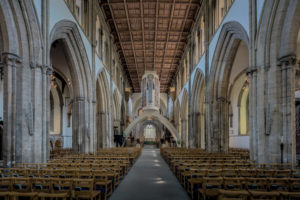There is the Medieval Craft of Dying and the Tibetan Book of the Dead, but among modern books The Theory of Eternal Life is the only one we know which could properly be called a Thanatology, – a textbook of the science of death and the life after death. THE THEORY OF ETERNAL LIFE, by Rodney Collin
Does man survive the death of his physical body? If so, where does he find himself and what are his various possibilities on the other side? In 1950 Rodney Collin, a scientist, mathematician, and close associate of P.D. Ouspensky, wrote perhaps the most significant book of our era on these difficult subjects. Its title is The Theory of Eternal Life; a first American edition has recently been published by Samuel Weiser.
In the brief space of 123 pages Collin succeeds in presenting a lucid summary of the startlingly exhaustive, precise, and consistent teaching of the great spiritual traditions of mankind on post-death existence: the judgment, rebirth, heaven, and hell. The most creative and eye-opening aspect of the book is the author ‘s corroboration of these timeless records with current mathematical and scientific data.
The Theory of Eternal Life draws on Egyptian, Greek, Zoroastrian, Hindu, Tibetan Buddhist, He brew, Sufi, and Christian religious sources-with Dante, Shakespeare, Rembrandt, Tolstoy, Ouspensky, and others included for good measure. An ordinary writer working with such an array of elements would be lucky to turn out anything more than a syncretistic stew. But Collin was no ordinary man. He was a working member of a real school of the Way; he was drawing on a knowledge bank available only to a very few in our age; and his efforts yielded a coherent and illuminating fusion of modern scientific clarity and ancient spiritual wisdom.
The thought of death commonly evokes one of two responses: revulsion, which results in people’s ignoring death as best they can; or unhealthy preoccupation, which causes them to regard death as weird, to sentimentalize it, or to create inner soap operas about it. Neither of these reactions is congruent with the view of the Way, the transcendent spiritual wisdom of the human race which is preserved for us in traditions that go back in time to when men were in closer contact with other worlds than they now are. The Way has always regarded death as the most important event of a person’s life, a time of potential beginning rather than a final end. Surviving Way instructions and rituals for relating to the dead are not superstition or primitive fantasy. They are fragments of a therapeutic art, once well-known but largely lost in modern times.
How a person dies matters a great deal. To quote Collin: The impact of such a change of state on a person who is completely unprepared for it, and whose whole being has been centered on physical phenomena, would inevitably produce unconscious ness, just as a man who had been locked in a dark cell for years, and was then suddenly driven out into bright sunlight, would be utterly blinded and would probably faint. The Tibetan Book of the Dead, indeed, emphasized that all ordinary men are thrown at death into a swoon which lasts three and a half days….
According to the Tibetan Book of the Dead, the Egyptian Book of the Dead, the medieval Book of the Craft of Dying, and other such teachings, intense preparation must be undergone by the dying man to make him able to bear the intense shock of new states. The quicker he can regain consciousness the higher will he be able to ascend and the more understand and experience.
The opening chapter of The Theory of Eternal Life explains the very different significances of time in an individual human being’s earthly phases of gestation, childhood, and maturity. Then follows a detailed and fascinating description of how the self-transits from the cellular world of the physical body to the molecular world of the soul at death, with a third stage -most significant of all- in the electronic world of the spirit. The latter part of the book explores the fourth realm – hell-which Collin characterizes as “petrifaction into the mineral world.” The critical factor of the judgment is discussed, and there is a full development of the ways and means by which a person can prepare to meet death as he is intended by God to do.
Anyone who is seriously interested in the life of the spirit should read this invaluable book. It is a mind-opener for anyone who has begun, as Maurice Nicoll says, “to seek for something additional, for something that will make him understand better, something that will help him and give him a direction and eventually complete him.” THE THEORY OF ETERNAL LIFE, by Rodney Collin



Leave a Reply
Your email is safe with us.
You must be logged in to post a comment.